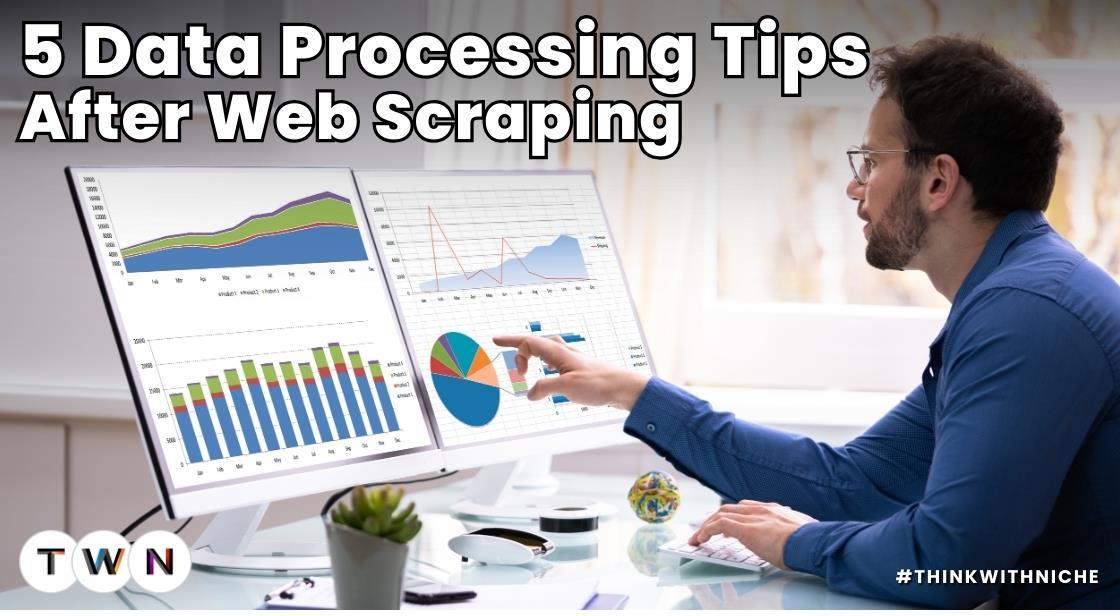5 Data Processing Tips After Web Scraping

Blog Post
Collecting data is just the first step- making it usable is where the real value lies. Discover essential post-web scraping processing techniques that turn raw, messy datasets into powerful, decision-ready resources that drive accuracy, efficiency, and business growth.
Introduction- From Raw Data to Reliable Insights
In the digital age, web scraping has become a cornerstone for gathering valuable information at scale. Whether for market research, competitive analysis, or product tracking, it offers businesses an edge by unlocking vast amounts of online data. Yet, the process does not end once the data is captured- raw datasets are rarely clean, consistent, or ready for immediate use.
Scraped data often contains duplicate entries, inconsistent formats, irrelevant information, or even inaccuracies that can lead to poor analysis and flawed decisions. This makes post-scraping processing an essential stage that bridges the gap between data collection and actionable insights.
A structured data cleaning workflow ensures that every record is accurate, relevant, and aligned with your business objectives. From removing redundancies to validating accuracy, each step adds clarity, precision, and reliability to your dataset. Done right, data processing not only enhances the quality of your analysis but also improves operational efficiency.
The Hidden Risks of Skipping Data Processing
Neglecting to refine scraped data is like trying to cook with spoiled ingredients- the outcome will be compromised from the start. Even sophisticated scraping tools can pull in unnecessary or flawed content, such as outdated listings, advertising elements, or mismatched date formats. Without cleaning and standardization, these issues can disrupt analytics and skew results.
Why You Must Read This Blog Post
By exploring this article/ blog post, you will learn:
- The importance of systematic cleaning to ensure data accuracy.
- How to standardize formats for seamless integration with your tools.
- Best practices for validating information to avoid costly errors.
- Transformation methods that prepare data for advanced analytics.
- How automation can maintain quality across large datasets.
Whether you are a data analyst, business strategist, or tech-driven entrepreneur, this guide equips you with the knowledge to turn raw scraped data into a high-quality asset that supports better decisions, sharper insights, and stronger results.
Web scraping is a good method of extracting information across online resources, but the information collected is hardly in the final format to be immediately applied. Duplicates, formatting differences, irrelevant entries and errors are the most common errors in raw scraped data. This data can be subject to faulty analysis and bad decisions greatly contributed by lack of proper cleaning and processing.
This is the reason why companies and analysts would give weight to the process of cleansing scraped data to be incorporated into systems or as a source of insights.
The extraction is as important as the post-scraping stage. An appropriate cleaning and processing make the data consistent, relevant, and usable. By doing it manually or in an automated fashion, you will generate more value to your data when you take time to polish it up. This step links the information gathering phase and transforms it into something that can be used to make decisions, report and create a strategy.
Removing Duplicate And Irrelevant Data
Determining and deleting duplicate records is one of the initial actions in data cleaning following the process of web scraping. This is a typical problem since it is common to scrape a record more than once when data is retrieved using a paginated content or multiple URL references that address a similar content. Duplicates may affect the analysis by giving undue attention to repeated records and thus they must be eliminated to achieve accuracy.
Another issue that needs to be overcome at an early stage of processing is irrelevant data. Web scraping is overwhelmingly likely to fetch irrelevant information besides what is actually required and may include puppy junks, advertisements or navigation bars or unwanted product listing. Eliminating these features decreases the noise in the data so that it is easy to concentrate on the important core data of interest that is pertinent to the analysis or the application.
Standardizing Data Formats
Sites are highly inconsistent in how they present their content and this inconsistency is echoed in the scraped data. To cite an instance, dates can be presented in a distinct format in different resources, different currencies can be indicated using different symbols or have different decimal patterns and names could be capitalized differently. Standardization of these formats is essential in the consideration of harmonization of all records with each other to be analyzed.
Standardization also improves integration with other systems. When scraped information is going into a database, a spread sheet, or analyzing tool, consistent formats can help avoid errors when importing and enable more accurate sorting, filtering and comparing. Creating this step should be conducted with mindfulness since trivial details may produce noticeable issues when it comes to large amounts of data.
Validating Data Accuracy
After cleansing the dataset of duplicates, standardizing it, and achieving the missing data where necessary, it is of prime importance to check the accuracy of the information. Validation can be done through referencing part of the scraped data with sources of trusted data to prove that it is aligned with reality. This is more important particularly in pricing and inventory or time sensitive information where similar information may be changed frequently.
In the case of companies that incorporate data extraction services, accuracy checks may be factored into the process in order to ensure quality in the long term. Basic validation not only increases the reliability but also assists in monitoring the changes of source websites that may impact on the scraping rules or an opportunity of collecting the wrong data to arise. This active way avoids the introduction of errors that pile up not to be seen in the data.
Transforming Data For Analysis
After assuring the accuracy, preparation of the data to best be used is the next step. This transformation step can be the generation of new calculated fields, aggregation of the values, or the dataset reorganization so it can be analyzed with analytics software. The objective would be to refine the cleaned data into a format that helps to facilitate an efficient and analytical analysis.
Even the process can include the transformation of data into categories or tags so it becomes easier to retain and compare. As an example, product data, which is scraped, may be categorized based on type or price range, then making the analysis more specific.
The better the data set is organized and more pertinent, the more it would be helpful in identifying the trends, patterns, and opportunities.
Automating The Cleaning And Processing Workflow
Cleaning and processing scraped data manually can work well, in the context of small projects, but quickly becomes uneconomical as the dataset scales. Automation can assist in performing the cleaning, standardization and transformation rule in all the records. This will save time, minimize the possibility of human error and keep the dataset current.
The incorporated automated cleaning workflow processes become a common practice in businesses as automated data collection points that effortlessly flow into data analysis. In this way, it allows them to track the changes on the go and react to the emergence of trends or market changes promptly. The automation makes sure that even large scale datasets are correct, clean and able to be used.
Conclusion: Transforming Raw Data into a Strategic Advantage
Clean, well-structured data is the backbone of effective decision-making. Post-scraping processing is where the true transformation happens- turning a chaotic collection of web content into a reliable resource you can trust. By committing to a systematic cleaning process, you ensure your data works for you, not against you.
The benefits go beyond improved accuracy. Consistent formatting enhances integration with business systems, validation ensures credibility, and thoughtful transformation makes datasets easier to analyze. Incorporating automation into your workflow not only saves time but also guarantees quality at scale, enabling you to respond faster to market changes and emerging trends.
When businesses treat data as a strategic asset rather than a byproduct of scraping, they unlock its full potential. Whether you are refining product listings, tracking pricing patterns, or monitoring industry activity, the way you process data directly impacts the quality of your insights and the success of your strategies.
In a competitive digital landscape, where information drives action, those who master both scraping and processing will always stay ahead.
Key Takeaways for Readers
- Data cleaning is essential to remove duplicates, irrelevant entries, and noise.
- Format standardization ensures seamless integration with analytics tools.
- Accuracy validation builds trust in the insights generated.
- Transformation techniques make data more relevant, categorized, and comparable.
- Automation saves time, reduces errors, and keeps large datasets current.
- High-quality processed data directly influences smarter decisions and better business outcomes.
Reader’s Disclaimer: This article is intended for informational purposes only. ThinkWithNiche does not endorse or promote any specific software, tools, or service providers mentioned directly or indirectly. Readers should assess their specific needs and conduct independent evaluations before implementing any strategies discussed here.












